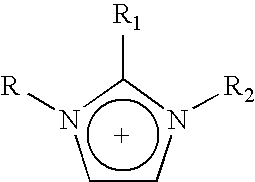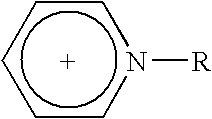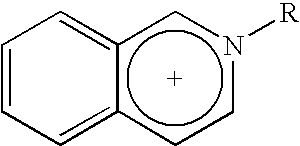Halogen-free ionic liquids in naphtha desulfurization and their recovery
a technology of ionic liquids and desulfurization, which is applied in the direction of solvent extraction, hydrocarbon oil treatment products, separation processes, etc., can solve the problems of high cost of process, high hygroscopicity of ionic liquids containing this anion type, and inability to stabilize to atmospheric humidity
- Summary
- Abstract
- Description
- Claims
- Application Information
AI Technical Summary
Problems solved by technology
Method used
Image
Examples
example 1
Synthesis of 1-hexyl-3-methyl-imidazolium acetate (LI-1)
Method 1 Conventional Heating
[0025]First step: An oven-dried, 100-mL, three-necked, round bottomed flask equipped with a magnetic stirring bar, thermometer and a reflux condenser is charged with 20 mmol 1-methyl-imidazole and 60 mmol of 1-bromohexane, the resulting solution was heated at 80° C. for 24 hr. At the end of this time, two phases were produced, the upper phase was decanted and the lower phase, which contained the ionic liquid, was washed with ethyl acetate (3×20-mL). The solvent was eliminated at reduced pressure.
[0026]Second step (Anion interchange): An oven-dried, 100-mL, three-necked, round bottomed flask equipped with a magnetic stirring bar, thermometer and a reflux condenser, were dissolved 10 mmol of 1-hexyl-3-methyl-imidazolium bromide obtained in first step, in 50-mL of acetonitrile. Silver acetate (10 mmol) was slowly added to the solution. The mixture was refluxed for 10 hr, and then the precipitated was f...
examples 2 to 8
[0029]The ionic liquids of this invention were synthesized using two different heating methods, the first one (conventional heating) and the second one (microwave heating). The interchange anion step was done using silver carboxylate (acetate, benzoate, butanoate and stearate). The ionic liquids of this invention were characterized by spectroscopic 1H and 13C Nuclear Magnetic Resonance data, the chemical shifts are reported in ppm in d6-DMSO and CDCl3 with tetramethylsilane as an internal Standard.
[0030]The spectroscopic data and yields of the ionic liquids synthesized in this invention are summarized as follows:
Yields and spectroscopic data of ionic liquids (1 to 8)Ionic Liquid 1 (LI-1)
Example 1Method 1 Yield 82%Method 2 Yield 90%1-hexyl-3-methyl-imidazolium acetate1H NMR (DMSO-d6) δ 0.82 (t, J = 6.9 Hz, 3H), 1.22 (m, 6H), 1.75 (sx,J = 5.6 Hz, 2H), 1.80 (s, 3H), 3.87 (s, 3H), 4.18 (t, J = 7.1 Hz, 2H), 7.78(dd, J1 = 1.6 Hz, J2 = 1.9 Hz, 1H), 7.87 (dd, J1 = 1.6 Hz, J2 = 1.9 Hz,1H), ...
example 9
Extraction of Sulfured Compounds from Naphtha
[0031]The procedure for the sulfured compound removal of the naphtha consisted of putting in contact one part of ionic liquid with 10 parts of naphtha (w / w) whose sulfur content has been determined previously. The mixture is shaken vigorously during 10 minutes, the two phases are separated and the sulfur content is determined in the naphtha after the extraction to determine the percentage of total sulfur removal. The determination of the sulfur content was carried out by method ASTM-D 5453-05: Standard Test for Method Determination of Total Sulfur in Light Hydrocarbons, Fuels Motor and Oils by Ultraviolet Fluorescence.
[0032]The percentage of sulfur removed after the extraction liquid-liquid is shown in Table 2.
TABLE 2Total sulfur removed% of total sulfurremoved of theIonic liquidgasolineLI-168LI-272LI-368LI-470LI-567LI-666LI-769LI-868Total sulfur in the natural gasoline: 210 ppmNote:LI-1 = 1-hexyl-3-methyl-imidazolium acetateLI-2 = 1-Octy...
PUM
| Property | Measurement | Unit |
|---|---|---|
| pressure | aaaaa | aaaaa |
| pressure | aaaaa | aaaaa |
| power | aaaaa | aaaaa |
Abstract
Description
Claims
Application Information
 Login to View More
Login to View More - R&D
- Intellectual Property
- Life Sciences
- Materials
- Tech Scout
- Unparalleled Data Quality
- Higher Quality Content
- 60% Fewer Hallucinations
Browse by: Latest US Patents, China's latest patents, Technical Efficacy Thesaurus, Application Domain, Technology Topic, Popular Technical Reports.
© 2025 PatSnap. All rights reserved.Legal|Privacy policy|Modern Slavery Act Transparency Statement|Sitemap|About US| Contact US: help@patsnap.com



